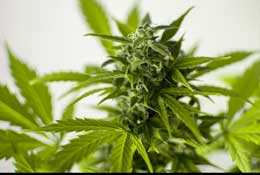An Interview with Dr Lee Know, ND
By Jason Sebeslav
Lee Know is a licensed naturopathic doctor, recipient of several awards, and has held positions as medical advisor, scientific evaluator, and director of R&D for major organizations. He’s the author of Mitochondria and the Future of Medicine (Chelsea Green Publishing, 2018) and the Director of Scientific Affairs for Cannanda. I had the opportunity to speak with Dr Know recently about the role of terpenes in stimulating the body’s endocannabinoid system for pain relief and other health benefits.
Jason Sebeslav: Dr Know, there seems to be plenty of research on the therapeutic potential of terpenes, particularly for pain. First, what are terpenes, and second, why haven’t we heard very much about them until now?
Lee Know: Terpenes are considered the “active” compounds in essential oils, and although the scientific community has known about these for many years, it’s only recently that they’re gaining recognition from the general public.
JS: So, are terpenes the compounds that make aromatherapy effective?
LK: Exactly. When we inhale the vapours of essential oils, we breathe in the terpenes, which then get absorbed through our lungs.
JS: What makes the terpenes used in Cannanda’s product line unique and so effective?
LK: Unlike essential oils, which contain a mix of various terpenes—many of which may not contribute to the effect you’re looking for, or just function as a scent—Cannanda starts with isolated terpenes to create our own blends where 100% of the formula is committed to the therapeutic effect you’re after. Think of our blends as super-potent essential oils that are highly targeted to specific biological processes. For example, our CB2 products effectively target the endocannabinoid system.
JS: Most of us were not aware that we had an “endocannabinoid system.” What is it?
LK: The endocannabinoid system (ECS) functions as the master regulator of homeostasis—balance within the body—and found within every tissue and organ. It’s made up of two main cannabinoid receptors (called CB1 and CB2) and “endocannabinoids” (which are produced by the body and mimics compounds from cannabis). When the normal function of our tissues or organs are disrupted, that specific area of the body produces more cannabinoid receptors, which are then activated by our endocannabinoids to bring things back into balance.
JS: The CB2 products are being touted as a “legal alternative” to CBD, which is currently only available by prescription. In simple terms, how similar are they?
LK: CBD is the popular cannabinoid found in cannabis and has tremendous therapeutic value. However, CBD is still a controlled substance and only legally available by prescription; so Cannanda launched CB2, which offers very similar benefits, but 100% legal with no prescription required. Most use CB2 on its own, but CBD users also like to use it as an add-on.
JS: So CB2 isn’t just an alternative but can also be a companion product for medical CBD users?
LK: Correct. On its own, CB2 is used as an alternative to CBD; however, for those already using CBD, adding Cannanda’s CB2 can enhance the effectiveness of CBD. This is especially true for those who are using CBD but perhaps not getting the benefits they thought they would.
JS: Many will be wondering if it’s possible to get a “high” from CB2 or the other blends.
LK: Absolutely not. With respect to the ECS, the “high” is associated with CB1 activation (the main cannabinoid receptor in the brain). For example, when THC—the notorious cannabinoid in cannabis—binds to CB1, users will get high. Activating CB2 receptors offers many of the benefits of cannabis, without the high.
JS: What are the main therapeutic benefits of activating CB2 and how strong is the science?
LK: The main benefit would be pain and inflammation, and the evidence is quite compelling. However, CB2 activation has been studied for benefits to heart disease, diabetes, obesity, dementia and Alzheimer’s, Parkinson’s and other neurodegenerative conditions, multiple sclerosis, rheumatoid arthritis, osteoarthritis, chronic pain, digestive disorders, migraines, asthma, and the list goes on.
JS: Are there any medical conditions or situations in which one should not consider using CB2?
LK: We always recommend that pregnant or breastfeeding women consult with their healthcare provider prior to use.
JS: Finally, is there a testimonial or success story that has been particularly striking?
LK: The most profound story is a woman who was getting Botox injections for migraines she’s had since childhood, and she was able to stop the injections after using our CB2. However, I’d say the most common testimonials are related to anti-anxiety benefits, and one woman wrote to us saying she’s no longer on anxiety meds or antidepressants and able to make it through her anxiety attacks with just our CB2 Wellness Blend (the aromatherapy version). The amazing thing with Cannanda’s CB2 is that it benefits your body wherever it’s out of balance. This is because cannabinoid receptors are up-regulated in those areas, essentially making our products like personalized therapy, but without any complicated tests or procedures.

